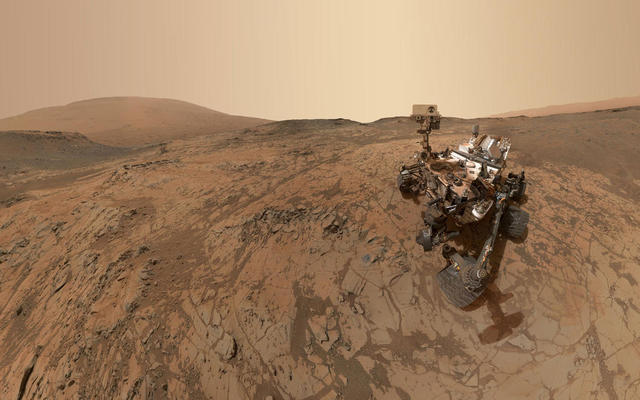Water on Mars! or, Bowie’s Last Chance
The NASA Curiosity Mars Rover traveled a long way through space to send back never-before-seen images from the Red Planet.
September 29, 2015
Martians have always been the favorite creature to talk about at bedtime, around campfires, and in the psych ward when it was generally understood that if our dry sister planet couldn’t support life, it was likely that no other place in our observable universe could support living organisms either. But, what if our sister planet is actually not as desolate as previously thought? Could there be Life On Mars?
On Monday, September 28, 2015, NASA called a conference and announced that liquid water has been found flowing on Mars. Using an imaging spectrometer, scientists were able to find evidence of different hydrated minerals in ‘streaks’ that seemed to flow faster or slower depending on the temperature of the seasons on a series of slopes. Lujendra Ojha of the Georgia Institute of Technology in a NASA press release confirms, “We found the hydrated salts…the detection of hydrated salts..means that water plays a vital role in the formation of these streaks.”
Of course, the next step in these findings is determining whether or not life is present where water flows and then if it could support human life. NASA, as per usual, is one step ahead and planning to land a rover on the surface set to launch in the year 2020. After that, it’s quite literally up in the air.
Volunteers, trained professionals, ordinary street walkers, and celebrities have been offering to be shot into space since 2013 after the eventual “Mars Mission” was announced. The fourth goal NASA has set for space exploration on Mars is a human mission-however, they want to get them back. As of right now, if humans were to go to Mars, they would die before ever having a chance to make it back to beautiful home base. Which means we must ask the question; is the evidence of liquid water on Mars enough to push the agenda for human space travel to the red planet despite ethical concerns?
When asked, Anna Landre, Dep. Secretary of NHD and Forensics Team Speech Captain, stated, “I think it does. If a prospective astronaut is willing to make it their life’s mission to go to Mars, and they understand the consequences fully, then it’s completely their choice. If that means wanting to take a one way trip to Mars for the sake of scientific discovery, so be it.” The consequences of the trip to the surface are still being figured out though it has been concluded that if astronauts survived the journey and landing, radiation would likely affect humans because of the lack of an ozone layer and the superoxides that break down organic molecules in soil could potentially damage human life. Though, there is the ever present concern of astronauts even surviving the journey.
“Our technology is not advanced enough,” Alison Pagalilauan, JSA representative of Biotechnology High School states. “They will die within the first two years of traveling.” She goes on further to say, “The people who volunteered to colonize mars…they’re not coming back.” Which, according to most, is the likely option.
The trip to Mars in an ideal launch window is nine months, the next window home appearing about three and a half months, and then nine months home, less than two years in total. However, with supplies, a crew, the weight of the fuel, and the complications, it’s estimated that the trip there would be more along the lines of six years. And the longest time anyone has ever spent in space was fourteen months with supplies being renewed.
All in all, the discovery of liquid water seems to be a step in the right direction on interstellar travel, yet there are many more to be taken before we ever leave a footprint in the red planet’s sand.






















































